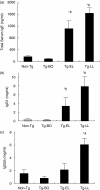The disease progression in the keratin 14 IL-4-transgenic mouse model of atopic dermatitis parallels the up-regulation of B cell activation molecules, proliferation and surface and serum IgE
- PMID: 16178852
- PMCID: PMC1809492
- DOI: 10.1111/j.1365-2249.2005.02894.x
The disease progression in the keratin 14 IL-4-transgenic mouse model of atopic dermatitis parallels the up-regulation of B cell activation molecules, proliferation and surface and serum IgE
Abstract
We have previously characterized the keratin 14 interleukin-4-transgenic (IL-4-Tg) mouse model of atopic dermatitis as a chronic pruritic inflammatory skin disease typified by skin infiltration of inflammatory cells and early up-regulation of Th2 cytokines and late surge of Th1 cytokines. In the present study, we examined the involvement of B cells. Systematic examinations of the following immunological parameters on B cells were carried out in non-Tg control mice and in IL-4-Tg mice at before disease onset and early and late disease stages so that we could determine the immunological sequence of events leading to the disease development: surface expressions of IA/IE, activation and costimulatory molecules, proliferation under LPS or IgM stimulation, quantification of cell surface and serum IgE, IgG1, and IgG2a. Our results showed that as the disease progresses from before onset to early disease and to late disease, there is a parallel increase in surface markers of B cell activation (IA/IE, CD44, CD69, CD80 and CD86), in B cell proliferation, and in cell surface and serum IgE. Significant increases of Th2-driven serum IgG1 and IgE in early disease was followed by significant increase of Th1-driven IgG2a in late disease. Importantly the significant increases of activation molecule (IA/IE), proliferation (to LPS), and surface IgE on B cells of the IL-4-Tg mice precedes the up-regulation of serum IgE and disease onset. These data suggest that activated B cells may play a role in atopic dermatitis disease development by up-regulating serum IgE concentration, which serves as a marker of disease onset.
Figures






References
-
- Kallstrom E, Roscher I, Andreasson A, Back O, van Hage-Hamsten M. Decreased frequency of intracellular IFN-gamma producing T cells in whole blood preparations from patients with atopic dermatitis. Exp Dermatol. 2002;11:556–63. - PubMed
-
- Jones HE, Inouye JC, McGerity JL, Lewis CW. Atopic disease and serum immunoglobulin-E. Br J Dermatol. 1975;92:17–25. - PubMed
-
- Jones HE, Wade TR. Relationship between atopic dermatitis and immunoglobulin E. Int J Dermatol. 1976;15:293–6. - PubMed
-
- Ohman S, Johansson SG. Immunoglobulins in atopic dermatitis with special reference to IgE. Acta Derm Venereol. 1974;54:193–202. - PubMed
-
- Novak N, Kraft S, Bieber T. Unraveling the mission of FcepsilonRI on antigen-presenting cells. J Allergy Clin Immunol. 2003;111:38–44. - PubMed
Publication types
MeSH terms
Substances
Grants and funding
LinkOut - more resources
Full Text Sources
Other Literature Sources
Molecular Biology Databases
Miscellaneous

